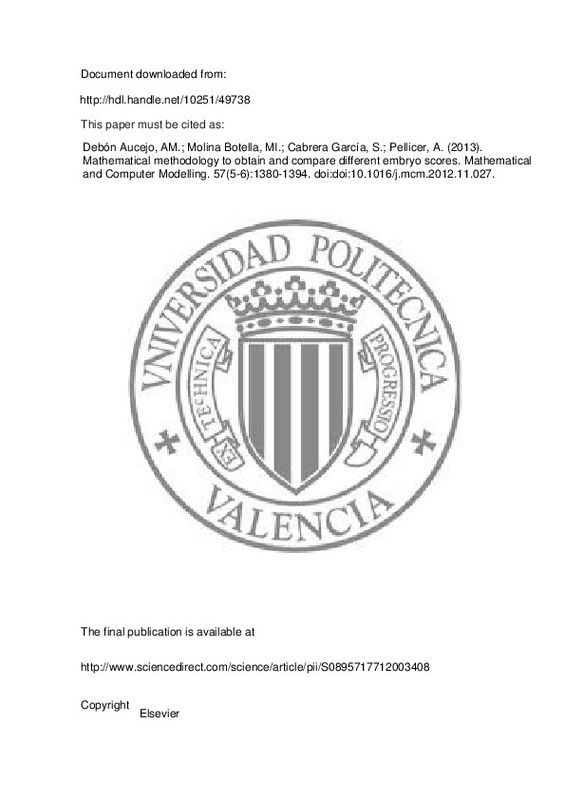JavaScript is disabled for your browser. Some features of this site may not work without it.
Buscar en RiuNet
Listar
Mi cuenta
Estadísticas
Ayuda RiuNet
Admin. UPV
Mathematical methodology to obtain and compare different embryo scores
Mostrar el registro sencillo del ítem
Ficheros en el ítem
| dc.contributor.author | Debón Aucejo, Ana María
|
es_ES |
| dc.contributor.author | Molina Botella, María Inmaculada
|
es_ES |
| dc.contributor.author | Cabrera García, Suitberto
|
es_ES |
| dc.contributor.author | Pellicer, A.
|
es_ES |
| dc.date.accessioned | 2015-05-06T06:00:31Z | |
| dc.date.available | 2015-05-06T06:00:31Z | |
| dc.date.issued | 2013 | |
| dc.identifier.issn | 0895-7177 | |
| dc.identifier.uri | http://hdl.handle.net/10251/49738 | |
| dc.description.abstract | In Vitro Fertilization (IVF) units need to decrease multiple pregnancies without affecting their overall success rate. In this study we propose a mathematical model to evaluate an embryo’s potential ability to implant in the uterus. Embryos are graded by the embryologist based on the number of blastomeres, evenness of growth and degree of fragmentation. Therefore, the following variables were considered: number of blastomeres produced by division of the egg after fertilisation (blastomeres), symmetry and fragmentation of the embryo (grade). This model evaluates the embryos assigning them a score which represents their quality. The main result derived from this model is the estimation of the significant improvement in the implantation rate due to the increase in blastomere values and the decrease in grade factor values. But the increase from two–three to four produces more improvement in the implantation rate than two–three to five–six blastomeres. First, statistical models were used to study embryo traceability from transfer to implantation and to evaluate the effect of the quality of the embryos (embryo score) and women’s age on implantation potential. This score was obtained by making predictions from the fitted model which was used to rank embryos in terms of implantation potential. Then we totalled the scores of embryos that had been transferred to each woman for obtaining the Embryo Quality Index (EQI). In addition, we studied the effects of EQI and women’s age on pregnancy. Finally, statistical techniques such as Receiver Operating Characteristics (ROC) and bootstrap procedures were used to assess the accuracy of this model. This embryo score is a quick, efficient and accurate tool to optimise embryo selection for transfers on the second day after fertilisation. This tool is especially useful for transfers involving non-top embryos. | es_ES |
| dc.description.sponsorship | This work was partially supported by a grant from the Generalitat Valenciana (grant no. GVPRE/2008/103). The research of AD and SC was partially supported by a grant from Ministerio de Asuntos Exteriores (grant no. A/023444/09) too. The authors are indebted to the anonymous referee whose comments and suggestions improved the paper considerably. | en_EN |
| dc.language | Español | es_ES |
| dc.publisher | Elsevier | es_ES |
| dc.relation.ispartof | Mathematical and Computer Modelling | es_ES |
| dc.rights | Reserva de todos los derechos | es_ES |
| dc.subject | Bootstrapping | es_ES |
| dc.subject | Embryo score | es_ES |
| dc.subject | ROC curve | es_ES |
| dc.subject | Generalised linear mixed models | es_ES |
| dc.subject | Categorical predictors | es_ES |
| dc.subject | Generalised linear models | es_ES |
| dc.subject.classification | ESTADISTICA E INVESTIGACION OPERATIVA | es_ES |
| dc.subject.classification | PRODUCCION ANIMAL | es_ES |
| dc.title | Mathematical methodology to obtain and compare different embryo scores | es_ES |
| dc.type | Artículo | es_ES |
| dc.identifier.doi | 10.1016/j.mcm.2012.11.027 | |
| dc.relation.projectID | info:eu-repo/grantAgreement/MAEC//A%2F023444%2F09/ES/TRANSFERENCIA DE TECNOLOGIA EDUCATIVA E INVESTIGACIÓN DE LA APLICACION DE LAS NUEVAS TECNOLOGÍAS EN LA DOCENCIA DE LA ESTADÍSTICA/ | es_ES |
| dc.relation.projectID | info:eu-repo/grantAgreement/GVA//GVPRE%2F2008%2F103/ | es_ES |
| dc.rights.accessRights | Abierto | es_ES |
| dc.contributor.affiliation | Universitat Politècnica de València. Grupo de Fenómenos Ondulatorios (GFO) | es_ES |
| dc.contributor.affiliation | Universitat Politècnica de València. Centro de Gestión de la Calidad y del Cambio - Centre de Gestió de la Qualitat i del Canvi | es_ES |
| dc.contributor.affiliation | Universitat Politècnica de València. Departamento de Estadística e Investigación Operativa Aplicadas y Calidad - Departament d'Estadística i Investigació Operativa Aplicades i Qualitat | es_ES |
| dc.contributor.affiliation | Universitat Politècnica de València. Departamento de Ciencia Animal - Departament de Ciència Animal | es_ES |
| dc.description.bibliographicCitation | Debón Aucejo, AM.; Molina Botella, MI.; Cabrera García, S.; Pellicer, A. (2013). Mathematical methodology to obtain and compare different embryo scores. Mathematical and Computer Modelling. 57(5-6):1380-1394. https://doi.org/10.1016/j.mcm.2012.11.027 | es_ES |
| dc.description.accrualMethod | S | es_ES |
| dc.relation.publisherversion | http://www.sciencedirect.com/science/article/pii/S0895717712003408 | es_ES |
| dc.description.upvformatpinicio | 1380 | es_ES |
| dc.description.upvformatpfin | 1394 | es_ES |
| dc.type.version | info:eu-repo/semantics/publishedVersion | es_ES |
| dc.description.volume | 57 | es_ES |
| dc.description.issue | 5-6 | es_ES |
| dc.relation.senia | 233643 | |
| dc.contributor.funder | Ministerio de Asuntos Exteriores y Cooperación | es_ES |
| dc.contributor.funder | Generalitat Valenciana | es_ES |







![[Cerrado]](/themes/UPV/images/candado.png)

